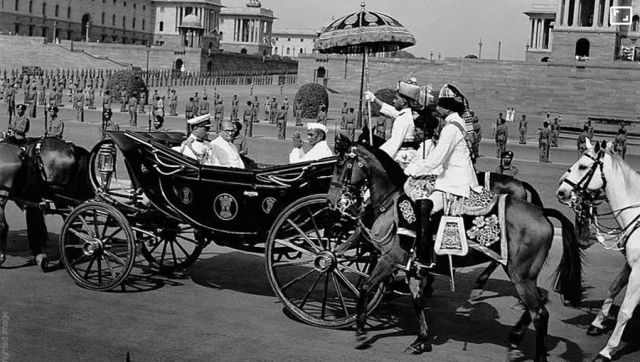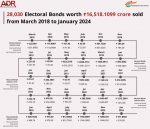Today (26 January), India marks its 75th Republic Day and President Droupadi Murmu will lead the nation’s celebrations from Kartavya Path. The grand R-Day parade will exhibit India’s military might as well as its vibrant diversity.
This year, the theme of the parade is ‘Viksit Bharat’ and ‘Bharat – Loktantra Ki Matruka’ and will see the participation of 13,000 special guests. In a first, the Republic Day parade will begin with 100 women artists playing Indian musical instruments such as Sankh, Naadswaram and Nagada, marking a shift from the past when this was done by military bands.
Catch live updates from Republic Day parade 2024 HERE
There’s also another interesting first to be witnessed this year: two French Rafale fighter jets and a Multi Role Tanker Transport (MRTT) aircraft will be in the flypast. Additionally, a 95-member French marching contingent and a 33-member band contingent will also take part in the celebrations.
But as we celebrate today and gear ourselves for a grand and majestic parade down Kartavya Path, let’s turn back the pages to revisit India’s first Republic Day celebrations.
India’s first R-Day parade in 1950
India became an independent country in 1947. However, for two years later it was yet to sever all ties with the British Empire. It still remained a British dominion, governed by the British-era Government of India Act of 1935, and officially still owing allegiance to the Crown.
However, this changed on 26 January 1950. It was on this very day that India’s newly drafted Constitution came into effect and the country became a sovereign republic.
It was decided by the leaders of the country then that India would hold a military parade on the day to commemorate this moment and to instil national pride in the hearts and minds of the people. It was also decided that India’s first president, Dr Rajendra Prasad, would take his oath at the parade.
According to historians, 26 January 1950, was a chilly Thursday morning and there was excitement in the air and among the people. The preparations were going on for weeks for the big day, the participants were rehearsing for the events on the historic day.
Chakravarti Rajagopalachari, the 34th and last governor-general of India, announced the birth of the Republic of India on 26 January.
After his oath ceremony, the first president of India addressed the crowd in Hindi and then in English.
“Today, for the first time in our long and chequered history we find the whole of this vast land… brought together under the jurisdiction of one constitution and one union which takes over responsibility for the welfare of more than 320 million men and women who inhabit it”, Dr Prasad was quoted as saying by BBC.
The Republic Day parade also had a chief guest in the form of then-Indonesian president Sukarno.
After being sworn in as the president, began the parade at the Irwin Ampitheatre opposite the Purana Qila, now known as the Major Dhyan Chand National Stadium.
Noted historian Ramchandra Guha in his book, India After Gandhi, writes that more than 3,000 men of the Indian Armed Forces marched in front of the president.
Moreover, after inspection of the parade by the President, the Artillery, fired a 31-gun salute, in three instalments. Notably, between these instalments, the parade fired a ‘Feu-de-joie’ or the fire of joy — a formal celebratory gunfire — thrice, and then gave three ‘jais’ to the President of the Republic. Indian Air Force’s Liberator planes flew overhead, to end this amazing spectacle.
Following this, the President’s horse-drawn carriage entered the stadium and escorted President Dr Prasad back to Government House (now Rashtrapati Bhawan).
Changes in the R-Day parade
Until 1954, the Republic Day parade continued to be held at the Irwin Stadium and it was only in 1955 that the location shifted to Rajpath, now known as Kartavya Path.
In the late 1950s and early ’60s, India also began to witness linguistic tensions, as the Centre tried to implement Hindi as the national language. Realising this unrest, the government then introduced a cultural aspect to the parade, by introducing tableaux and flotillas.
This made the parade not only more cultural and colourful but also longer. As historian Srinath Raghavan said to the BBC, “For Indians, the parade was primarily a symbolic affair that reinforced their identity as part of a powerful republic.”
Also read: How a military parade became India’s R-Day tradition
Special attractions at Republic Day 2024
And as the years passed by, the parades became a beautiful spectacle. This year, there are some attractions that will make the parade unmissable. An all-women tri-services group will be part of parade for the first time. And as ANI reported, the group comprises women troops from the Army’s military police and personnel from the other two services.
Culturally, one of the most special attractions at the parade will be the culture ministry’s showcase of sarees from various Indian states and union territories, to be presented in the ‘Anant Sutra’ exhibition. It will display around 1,900 sarees and drapes from all corners of India, creatively mounted on wooden frames along the Kartavya Path.
A French refuel aircraft and two French Rafale aircraft will also grace the skies in a flypast.
With inputs from agencies
Link to article –





